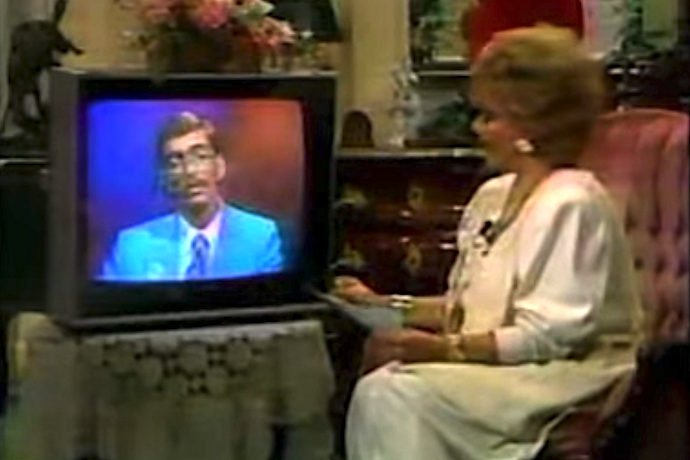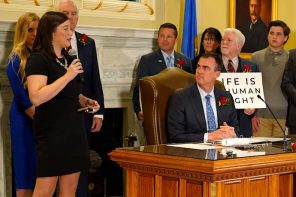“This is not my first plague.” In 1982, Rev. Steve Pieters was the first minister diagnosed with AIDS in the Metropolitan Community Churches (MCC), a denomination that lost a third of its clergy to the disease. In 1985, he was the first openly gay man and person with AIDS interviewed by Tammy Faye Bakker on The PTL Club, a Christian TV show and cultural staple of the early Christian Right. Today he’s retired from ministry, locked down at home, and “trying to be of service over the phone and zoom” to people in his church facing another pandemic.
Pieters is part of a unique cohort for whom the current pandemic is both eerily familiar and puzzlingly different. LGBT Christian clergy who ministered in queer communities in the 1980s and 90s are engaging Covid-19 using some lessons learned from AIDS ministry in the years before treatment. They’re also grappling with the spiritual, political, and social lessons we failed to learn in that epidemic; lessons that are re-emerging in this one.
Bishop Zachary Jones re-experienced the feeling of being utterly absorbed in the immediacy of a medical crisis when taking part in the daily ritual of thanking New York health care workers. “While I was banging this tambourine I was like oh my God, I remember what it meant to deal with case after case after case.” Jones, a bishop in the Unity Fellowship, started his work in AIDS and LGBTQ ministry driving Unity founder Rev. Carl Beans to his seemingly endless hospital visits in the AIDS units of 1980s Los Angeles.
Rev. Penny Nixon, who ministered in MCC’s San Francisco congregation in the 1990s, felt bodily memories of AIDS ministry rise in the first few weeks of Covid and then recede in the face of the also-familiar need to put feelings away and get to work. “How we got through the last pandemic,” she said, “it became the reality. You put your head down and you do it.”
For Karen Ziegler, the political parallels have been almost uncanny. She was the pastor of the MCC congregation in Greenwich Village for a decade that spanned the emergence of AIDS. “I realized early on in the Trump administration that it felt like the 80s when Ronald Reagan was elected and then there was this sharp, visible turn to the right,” she said. Part of that rightward turn is the way that AIDS and Covid revealed the often implicit American political calculation of whose lives are valued. The contrast between the anti-gay backlash in the first years of AIDS and the backlash against people of color evident in both epidemics is “helping me to understand that the original lie of America is this white superiority and all the kinds of supremacy that allows some people to think that other people don’t matter. All of that has become so visible.”
There are big differences in the physical and social trajectories of the respective diseases. In its early years AIDS was a very visible disease and, as Rev. Jim Mitulski recalled, an ugly one. Mitulski ministered with Nixon at the MCC congregation in San Francisco. Jones remembered seeing people getting sicker and sicker, week after week. “Death was much slower,” he said. And for all of the losses of Covid, the length of illness, for most, is much shorter and the possibility of survival much greater.
When Pieters was first diagnosed there was no treatment for AIDS. He considered himself lucky to have a doctor who advised “if there’s a one in a million chance that you can survive this, why not believe that you are that one in a million? Just believe that. And act like it.” People with Covid have a much higher rate of survival. “Eighty percent, eighty-five percent will survive this. And that’s a lot easier to believe than one in a million,” he said.
“It’s baffling,” Jones said, “the difference stigma brings to a pandemic.” It’s the most striking difference between the diseases these clergy have noticed. An early AIDS diagnosis was often intertwined with sexuality, sometimes with substance abuse, and always with social shame. Clergy had to minister to all three in addition to the disease. Jones remembers it as a kind of spiritual triage where he was always trying to figure out the most pressing need to respond to in any given case. “There were times that we just didn’t know what we were dealing with until hindsight,” he said. AIDS, recalled Nixon, was “religiously stigmatized in a way this pandemic is not.”
Isolation and aloneness have been challenges of pastoral care and spiritual leadership in both epidemics, albeit in very different forms. In the early years, the isolation of people with AIDS was visceral. Many were socially—and sometimes medically—shunned. The pastoral challenge was to make congregations spaces where people with AIDS were seen, welcomed, touched, and included. Nixon remembered how MCC San Francisco shaped ritual around the experience of AIDS. “[W]hether it’s the men coming with their IV poles coming to church [or] laying on the pews, their bodies were recognized as sacred and holy in that moment. That was a powerful corrective to society. And to religion. And to church.” All the clergy I talked to made church environments that countered the fear of disease by bringing people physically close.
With Covid, Bishop Yvette Flunder notes, the challenge is to keep people connected when the virus keeps them physically apart. Flunder started Ark of Refuge, one of the first AIDS ministries in a black church, in the mid-80s. Today she’s the pastor at City of Refuge, a UCC/Metho-Bapti-Costal church, and leads The Fellowship of Affirming Ministries, a global community of churches committed to radical inclusivity. With AIDS, she recalled, people who looked sick were marginalized “because of the position that the church took that if you have this dirty disease you’re a dirty person. But in this particular environment it’s the church that’s the dirty person. It’s [coming to] church that can make church people sick. Which flips the script.” And flips the pastoral task.
Ministry in LGBTQ communities provided at least two tools that have been useful in that new task. One is spiritual grounding in what Flunder calls a “consistent ethics of self care.” “[W]e talked about barriers and condoms back in the day, and safe sex practices. I now talk about social distancing and masks. And for me it’s six in one hand, half a dozen in another. Protect yourself. Be responsible not just for yourself but for your partner. . . . It’s really not different.”
Another is the skill of ritual innovation, honed in ministry to people whose life passages were not ritually marked in the eyes of the dominant culture. “God didn’t go away” in either epidemic, said Mitulski. “Our ability to craft ritual, our imagination has not dissipated or dried up.” Queer churches have long had to create rituals to counter that exclusion and make the sanctification of queer life feel real.
This has translated into creative experimentation with making virtual church feel real. Flunder’s church has grown since the epidemic. “We’ve had all kinds of ritual online,” she said, including different sacraments from the African-American Christian church and the indigenous spiritual communities that make up her congregation. They’ve also experimented with outdoor rituals. “[We] broadcast through our radios and through cell phones so that we could see each other. . . . We gave people little disposable communion kits and we had communion on the parking lot and blew our horns something fierce… you know, made a lot of noise.”
Like all of us, these ministers are looking toward the time when science and medicine change the trajectory of the Covid epidemic. But they also remember the challenges that change can bring. One is the need to address the compounded grief and loss that can so easily be skipped over in the midst of crisis. Pieters remembers that “when the drumbeat of death slowed down in ‘96, ‘97, there was a palpable feeling of deep depression among a lot of people who worked in AIDS. A deep grief,” which he attributed to losses unattended to.
“Think about all the un-mourned people who’ve died.” Mitulski said. “And the fact that they died in solitude. We’ve got to deal with it or it’s going to fuck people up for a long time.” In a 1999 sermon, given three years after protease inhibitors changed the course of AIDS in his congregation, Mitulski reminded them that AIDS wasn’t over. AIDS still isn’t over. And it fuels his admonition that, if and when the course of Covid changes, we attend to its afterlives. And especially to the enduring inequalities that both epidemics make inescapably clear.





